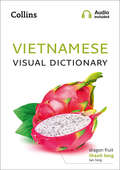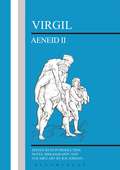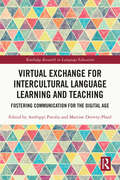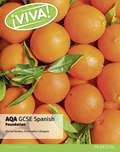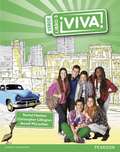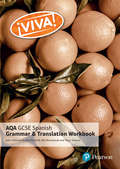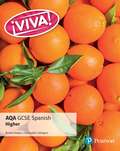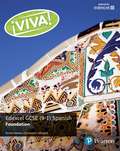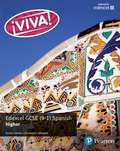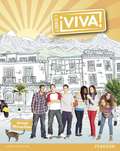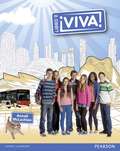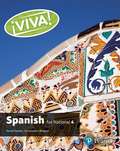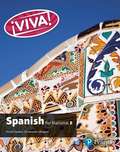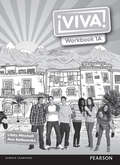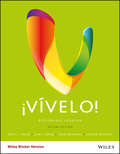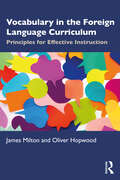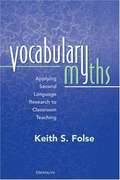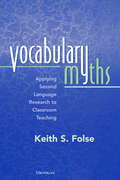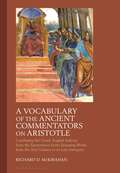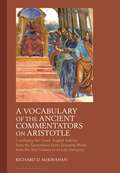- Table View
- List View
Vietnamese Visual Dictionary: A Photo Guide To Everyday Words And Phrases In Vietnamese (Collins Visual Dictionary)
by Collins DictionariesA photographic guide to the key words and phrases in Vietnamese. This attractive pocket-sized book is a perfect travel companion and provides a practical guide to Vietnam and Vietnamese language and culture.
Virgil: Aeneid II
by Virgil R. H. JordanIn Book II of the "Aeneid", Aeneas relates to Dido his own account of Troy's destruction and his escape, including the episode of the Wooden Horse. It is some of the best Latin poetry ever written, and thus makes an ideal introduction to the "Aeneid". This completely new edition aims to provide students with help in translation, encourage them to consider the sound of the poetry, and appreciate the emotional impact of the story as Virgil portrays it. The text also includes a general introduction, a select bibliography, notes and a full vocabulary; appendices deal with meter and scansion.
Virgil: Aeneid Ii (Latin Texts Ser.)
by Virgil R. H. JordanIn Book II of the "Aeneid", Aeneas relates to Dido his own account of Troy's destruction and his escape, including the episode of the Wooden Horse. It is some of the best Latin poetry ever written, and thus makes an ideal introduction to the "Aeneid". This completely new edition aims to provide students with help in translation, encourage them to consider the sound of the poetry, and appreciate the emotional impact of the story as Virgil portrays it. The text also includes a general introduction, a select bibliography, notes and a full vocabulary; appendices deal with meter and scansion.
Virgil, Aeneid 11, Pallas and Camilla, 1–224, 498–521, 532–596, 648–689, 725–835: Latin Text, Study Aids with Vocabulary, and Commentary (Classics Textbooks #7)
by Ingo Gildenhard John HendersonA dead boy (Pallas) and the death of a girl (Camilla) loom over the opening and the closing part of the eleventh book of the Aeneid. Following the savage slaughter in Aeneid 10, the book opens in a mournful mood as the warring parties revisit yesterday’s killing fields to attend to their dead. One casualty in particular commands attention: Aeneas’ protégé Pallas, killed and despoiled by Turnus in the previous book. His death plunges his father Evander and his surrogate father Aeneas into heart-rending despair – and helps set up the foundational act of sacrificial brutality that caps the poem, when Aeneas seeks to avenge Pallas by slaying Turnus in wrathful fury. Turnus’ departure from the living is prefigured by that of his ally Camilla, a maiden schooled in the martial arts, who sets the mold for warrior princesses such as Xena and Wonder Woman. In the final third of Aeneid 11, she wreaks havoc not just on the battlefield but on gender stereotypes and the conventions of the epic genre, before she too succumbs to a premature death. In the portions of the book selected for discussion here, Virgil offers some of his most emotive (and disturbing) meditations on the tragic nature of human existence – but also knows how to lighten the mood with a bit of drag. This course book offers the original Latin text, vocabulary aids, study questions, and an extensive commentary. Designed to stretch and stimulate readers, Ingo Gildenhard’s volume will be of particular interest to students of Latin studying for A-Level or on undergraduate courses. It extends beyond detailed linguistic analysis to encourage critical engagement with Virgil’s poetry and the most recent scholarly thought. King's College, Cambridge, has generously contributed to this publication.
Virtual Exchange for Intercultural Language Learning and Teaching: Fostering Communication for the Digital Age (Routledge Research in Language Education)
by Anthippi Potolia Martine Derivry-PlardThis book illustrates new virtual intercultural practices for language learning from primary to tertiary education and highlights the transversality of these practices throughout the language curriculum. The current English as a Lingua Franca (ELF) perspective sets the framework as a possible vector of cultural exchanges in a variety of contexts, and from which the different authors coming from Europe and all over the world present their studies. The book deploys diverse educational exchanges within a wide range of technological tools and with varied approaches to the intercultural dimension in language learning. Through these virtual exchanges, different languages and educational cultures come together to create emerging communities of practice co-constructed for the limited time-space of the collaborative projects. This volume opens a dialogue with researchers from different backgrounds and theoretical and methodological perspectives as technology can no longer be apprehended without its purposeful human and semiotic meanings and, conversely, human and semiotic meanings can no longer be apprehended without Information and Communication Technology (ICT). Going beyond strict polarised views on the technology or humanistic approaches, this book presents a more nuanced, interrelated stance and will appeal to researchers, scholars, post graduate students, and teachers in applied linguistics, language learning and teaching, education, information studies, cultural studies, and intercultural communication.
Virtual Exchange for Intercultural Language Learning and Teaching: Fostering Communication for the Digital Age (Routledge Research in Language Education)
by Anthippi Potolia Martine Derivry-PlardThis book illustrates new virtual intercultural practices for language learning from primary to tertiary education and highlights the transversality of these practices throughout the language curriculum. The current English as a Lingua Franca (ELF) perspective sets the framework as a possible vector of cultural exchanges in a variety of contexts, and from which the different authors coming from Europe and all over the world present their studies. The book deploys diverse educational exchanges within a wide range of technological tools and with varied approaches to the intercultural dimension in language learning. Through these virtual exchanges, different languages and educational cultures come together to create emerging communities of practice co-constructed for the limited time-space of the collaborative projects. This volume opens a dialogue with researchers from different backgrounds and theoretical and methodological perspectives as technology can no longer be apprehended without its purposeful human and semiotic meanings and, conversely, human and semiotic meanings can no longer be apprehended without Information and Communication Technology (ICT). Going beyond strict polarised views on the technology or humanistic approaches, this book presents a more nuanced, interrelated stance and will appeal to researchers, scholars, post graduate students, and teachers in applied linguistics, language learning and teaching, education, information studies, cultural studies, and intercultural communication.
Viva!: AQA GCSE Spanish, Foundation student book (PDF)
by Christopher Lillington Rachel HawkesExpertly structured Student Book for AQA GCSE 2016 Spanish (foundation tier). Designed to help learners use language independently and to the best of their ability, with fresh and engaging content from the target language culture. Designed for the new AQA GCSE Spanish qualification (foundation tier). A carefully designed programme of learning teaches the 'building blocks' of Spanish grammar and vocabulary. Includes popular topics, authentic material and real life-contexts; all with links to the Spanish culture. Each unit and module is structured to allow gradual progression. Exam preparation units are included for Reading, Writing, Speaking and Listening. Revision forms the final module.
Viva!: Verde Pupil Book 3 (PDF)
by Anneli Mclachlan Rachel Hawkes Christopher LillingtonUPSILONViva is packed with content your pupils will enjoy learning, with a tried-and-tested approach to progression. 9781447947370 9781447947318 9781447960331
Viva! 1 Workbook B Pack (PDF)
by Ana Kolkowska Libby Mitchell'Viva' Spanish resources are packed with content your pupils will enjoy learning. Plus, they move at the right place - whether or not your pupils have prior knowledge - and they open the window to the Spanish-speaking world.
Viva! Aqa Gcse Spanish Grammar And Translation Workbook (Viva! AQA GCSE Spanish)
by Tracy Traynor Ian Kendrick John Halksworth Ben KonopinskiA dedicated workbook to support and consolidate grammar learning and translation skills for AQA GCSE Spanish for first teaching from 2016. Includes: explanations of key grammar points, verb tables, and exercises to embed grammar knowledge translation exercises and strategies for translation both into Spanish and into English a bank of revision translations bringing together grammar and vocabulary learning from throughout the course clear links to the Viva! Student Books from the same series.
Viva! AQA GCSE Spanish Higher Student Book (PDF)
by Rachel Hawkes Christopher LillingtonExpertly structured Student Book for AQA GCSE Spanish (higher tier) for first teaching from 2016. Designed to help learners use language independently and to the best of their ability, with fresh and engaging content from the target language culture. Designed for the new AQA GCSE Spanish qualification (foundation tier). A carefully designed programme of learning teaches the 'building blocks' of Spanish grammar and vocabulary. Includes popular topics, authentic material and real life-contexts; all with links to the Spanish culture. Each unit and module is structured to allow gradual progression. Exam preparation units are included for Reading, Writing, Speaking and Listening. Revision forms the final module.
Viva! Edexcel GCSE Spanish Foundation Student Book (PDF)
by Rachel Hawkes Christopher LillingtonExpertly structured Student Book for Edexcel GCSE (9-1) Spanish (foundation tier). Designed to help learners use language independently and to the best of their ability, with fresh and engaging content from the target language culture. Designed for the new Edexcel GCSE (9-1) Spanish qualification (foundation tier). A carefully designed programme of learning teaches the 'building blocks' of Spanish grammar and vocabulary. Includes popular topics, authentic material and real life-contexts; all with links to the Spanish culture. Each unit and module is structured to allow gradual progression. Exam preparation units are included for Reading, Writing, Speaking and Listening. Revision forms the final module.
Viva! Edexcel Gcse Spanish Higher Student Book (PDF)
by Rachel Hawkes Christopher LillingtonExpertly structured Student Book for Edexcel GCSE (9-1) Spanish (higher tier). Designed to help learners use language independently and to the best of their ability, with fresh and engaging content from the target language culture. Suitable for the new Edexcel GCSE (9-1) Spanish qualification (higher tier). A carefully designed programme of learning teaches the 'building blocks' of Spanish grammar and vocabulary. Includes popular topics, authentic material and real life-contexts; all with links to the Spanish culture. Each unit and module is structured to allow gradual progression. Exam preparation units are included for Reading, Writing, Speaking and Listening. Revision forms the final module.
Viva! Pupil Book 1 (PDF)
by Anneli MclachlanViva! is a new fully-differentiated Key Stage 3 Spanish course packed with content pupils will enjoy learning and which opens the window to the Spanish-speaking world. With a strong focus on developing language learning skills, Viva! encourages students to manipulate language independently, helping to prepare them for KS4 and beyond.
Viva! Pupil Book 2 (PDF)
by Anneli MclachlanLanguage is introduced in short, easy-to-remember phrases.
¡Viva! Spanish for National 4 (PDF)
by Rachel Hawkes Christopher Lillington¡Viva! for National 4 is an expertly developed course, which will help students achieve their potential in Spanish National 4. The course develops listening, speaking, reading and writing skills and includes a focus on skills such as translation, understanding authentic and literary texts and spontaneous speaking. Cultural content and a focus on ‘learning something new’ help to give students a sense of purpose and bring language learning to life. A ‘building-blocks’ approach in which language and grammar are introduced and recycled helps students use language independently across contexts.
¡Viva! Spanish for National 5 (PDF)
by Rachel Hawkes Christopher Lillington¡Viva! for National 5 is an expertly developed course, which will help students achieve their potential in Spanish National 5. The course develops listening, speaking, reading and writing skills and includes a focus on skills such as translation, understanding authentic and literary texts and spontaneous speaking. Cultural content and a focus on ‘learning something new’ help to give students a sense of purpose and bring language learning to life. A ‘building-blocks’ approach in which language and grammar are introduced and recycled helps students use language independently across contexts.
Viva! Workbook 1A (Viva!)
by Ana Kolkowska Libby MitchellThis workbook features lots of reading and writing activities and is ideal for homework and cover lessons.
¡Vívelo!: Beginning Spanish
by Dolly J. Young Jane E. Berne Pablo Muirhead Claudia MontoyaLearning Spanish can be a difficult process but ¡Vívelo! makes it easier by offering a fresh approach. It emphasizes what readers know and can readily do with the language. The book includes activities that are designed to encourage readers to make cultural comparisons and connections. These activities, such as signature searches, information gap and jigsaw, are incorporated throughout the chapters to encourage a better comprehension of meaning with a purpose. ¡Vívelo! also offers metacognitive strategies to facilitate processing of advanced structures. The heavy emphasis on content and experiential learning empowers readers to gain a stronger understanding of Spanish.
Vocabulary in the Foreign Language Curriculum: Principles for Effective Instruction
by James Milton Oliver HopwoodWritten by experts in the field, this book explains the principles of effective vocabulary instruction for the modern language classroom. While many language classrooms rely on practices which can be outdated, idiosyncratic or ill-advised, this book overviews the research and background necessary to successfully integrate vocabulary instruction into the curriculum in a systematic way. Starting with the common gaps in vocabulary instruction, Milton and Hopwood demonstrate how students’ development of a large, communicative lexicon, with an understanding of word structure and collocations, is an essential component of language instruction. The book addresses goal setting, curriculum design, word selection, how words are learned, learning in and outside of the classroom and more. It also addresses common myths about teaching vocabulary in the United Kingdom and around the world. This comprehensive text fills an important gap in the literature and is ideal for undergraduate and postgraduate courses in world language/foreign language methods and language methods courses.
Vocabulary in the Foreign Language Curriculum: Principles for Effective Instruction
by James Milton Oliver HopwoodWritten by experts in the field, this book explains the principles of effective vocabulary instruction for the modern language classroom. While many language classrooms rely on practices which can be outdated, idiosyncratic or ill-advised, this book overviews the research and background necessary to successfully integrate vocabulary instruction into the curriculum in a systematic way. Starting with the common gaps in vocabulary instruction, Milton and Hopwood demonstrate how students’ development of a large, communicative lexicon, with an understanding of word structure and collocations, is an essential component of language instruction. The book addresses goal setting, curriculum design, word selection, how words are learned, learning in and outside of the classroom and more. It also addresses common myths about teaching vocabulary in the United Kingdom and around the world. This comprehensive text fills an important gap in the literature and is ideal for undergraduate and postgraduate courses in world language/foreign language methods and language methods courses.
Vocabulary Myths: Applying Second Language Research to Classroom Teaching (PDF)
by Keith S. FolseIn Vocabulary Myths, Keith S. Folse breaks down the teaching of second language vocabulary into eight commonly held myths. In debunking each myth, he introduces the myth with a story based on his 25 years of teaching experience (in the United States and abroad), continues with a presentation of what empirical research has shown on the topic, and finishes with a list of what teachers can do in their classrooms to facilitate true vocabulary acquisition. The goal of Vocabulary Myths is to foster a paradigm shift that correctly views vocabulary as fundamental in any second language learning process and demonstrates that research supports this goal-that in fact there is a wealth of empirical evidence to support these views. In addition, an important theme is that teachers have overestimated how much vocabulary students really understand, and as a result, the so-called "comprehensible input" is neither comprehensible nor input. The second language vocabulary acquisition myths reexamined in this book are: *In learning another language, vocabulary is not as important as grammar or other areas. *Using word lists to learn L2 vocabulary is unproductive. *Presenting new vocabulary in semantic sets facilitates learning. *The use of translations to learn new vocabulary should be discouraged. *Guessing words from context is an excellent strategy for learning L2 vocabulary. *The best vocabulary learners make use of one or two really specific vocabulary learning strategies. *The best dictionary for L2 learners is a monolingual dictionary. *Teachers, textbooks, and curricula cover L2 vocabulary adequately.
Vocabulary Myths: Applying Second Language Research to Classroom Teaching
by Keith S. FolseIn Vocabulary Myths, Keith S. Folse breaks down the teaching of second language vocabulary into eight commonly held myths. In debunking each myth, he introduces the myth with a story based on his 25 years of teaching experience (in the United States and abroad), continues with a presentation of what empirical research has shown on the topic, and finishes with a list of what teachers can do in their classrooms to facilitate true vocabulary acquisition. The goal of Vocabulary Myths is to foster a paradigm shift that correctly views vocabulary as fundamental in any second language learning process and demonstrates that research supports this goal-that in fact there is a wealth of empirical evidence to support these views. In addition, an important theme is that teachers have overestimated how much vocabulary students really understand, and as a result, the so-called "comprehensible input" is neither comprehensible nor input. The second language vocabulary acquisition myths reexamined in this book are: *In learning another language, vocabulary is not as important as grammar or other areas. *Using word lists to learn L2 vocabulary is unproductive. *Presenting new vocabulary in semantic sets facilitates learning. *The use of translations to learn new vocabulary should be discouraged. *Guessing words from context is an excellent strategy for learning L2 vocabulary. *The best vocabulary learners make use of one or two really specific vocabulary learning strategies. *The best dictionary for L2 learners is a monolingual dictionary. *Teachers, textbooks, and curricula cover L2 vocabulary adequately.
A Vocabulary of the Ancient Commentators on Aristotle: Combining the Greek–English Indexes from the Eponymous Series Spanning Works from the 2nd Century CE to Late Antiquity
by Richard D. McKirahanAn astounding project of analysis on more than one hundred translations of ancient philosophical texts, this index of words found in the Ancient Commentators on Aristotle series comprises some 114,000 entries. It forms in effect a unique dictionary of philosophical terms from the post-Hellenistic period through to late antiquity and will be an essential reference tool for any scholar working on the meaning of these ancient texts. As traditional dictionaries have usually neglected to include translation examples from philosophical texts of this period, scholars interested in how meanings of words vary across time and author have been ill served. This index fills a huge gap, therefore, in the lexical analysis of ancient Greek and has application well beyond the reading of ancient philosophical commentaries. Bringing together the full indexes from 110 of the volumes published in Bloomsbury's Ancient Commentators on Aristotle series, McKirahan has combined each word entry and analysed how many times particular translations occur. He presents his findings numerically so that each meaning in turn has a note as to the number of times it is used. For meanings that are found between one and four times the volume details are also given so that readers may quickly and easily look up the texts themselves.
A Vocabulary of the Ancient Commentators on Aristotle: Combining the Greek–English Indexes from the Eponymous Series Spanning Works from the 2nd Century CE to Late Antiquity
by Richard D. McKirahanAn astounding project of analysis on more than one hundred translations of ancient philosophical texts, this index of words found in the Ancient Commentators on Aristotle series comprises some 114,000 entries. It forms in effect a unique dictionary of philosophical terms from the post-Hellenistic period through to late antiquity and will be an essential reference tool for any scholar working on the meaning of these ancient texts. As traditional dictionaries have usually neglected to include translation examples from philosophical texts of this period, scholars interested in how meanings of words vary across time and author have been ill served. This index fills a huge gap, therefore, in the lexical analysis of ancient Greek and has application well beyond the reading of ancient philosophical commentaries. Bringing together the full indexes from 110 of the volumes published in Bloomsbury's Ancient Commentators on Aristotle series, McKirahan has combined each word entry and analysed how many times particular translations occur. He presents his findings numerically so that each meaning in turn has a note as to the number of times it is used. For meanings that are found between one and four times the volume details are also given so that readers may quickly and easily look up the texts themselves.
